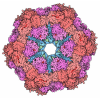+ Open data
Open data
- Basic information
Basic information
| Entry | Database: PDB / ID: 8h3u | ||||||
|---|---|---|---|---|---|---|---|
| Title | Inhibitor-bound EP, polyA model | ||||||
 Components Components |
| ||||||
 Keywords Keywords | MEMBRANE PROTEIN / complex | ||||||
| Function / homology |  Function and homology information Function and homology informationenteropeptidase / brush border / serine-type endopeptidase activity / proteolysis / membrane Similarity search - Function | ||||||
| Biological species |  Homo sapiens (human) Homo sapiens (human) | ||||||
| Method | ELECTRON MICROSCOPY / single particle reconstruction / cryo EM / Resolution: 4.7 Å | ||||||
 Authors Authors | Ding, Z.Y. / Huang, H.J. | ||||||
| Funding support | 1items
| ||||||
 Citation Citation |  Journal: Nat Commun / Year: 2022 Journal: Nat Commun / Year: 2022Title: Cryo-EM structures reveal the activation and substrate recognition mechanism of human enteropeptidase. Authors: Xiaoli Yang / Zhanyu Ding / Lisi Peng / Qiuyue Song / Deyu Zhang / Fang Cui / Chuanchao Xia / Keliang Li / Hua Yin / Shiyu Li / Zhaoshen Li / Haojie Huang /  Abstract: Enteropeptidase (EP) initiates intestinal digestion by proteolytically processing trypsinogen, generating catalytically active trypsin. EP dysfunction causes a series of pancreatic diseases including ...Enteropeptidase (EP) initiates intestinal digestion by proteolytically processing trypsinogen, generating catalytically active trypsin. EP dysfunction causes a series of pancreatic diseases including acute necrotizing pancreatitis. However, the molecular mechanisms of EP activation and substrate recognition remain elusive, due to the lack of structural information on the EP heavy chain. Here, we report cryo-EM structures of human EP in inactive, active, and substrate-bound states at resolutions from 2.7 to 4.9 Å. The EP heavy chain was observed to clamp the light chain with CUB2 domain for substrate recognition. The EP light chain N-terminus induced a rearrangement of surface-loops from inactive to active conformations, resulting in activated EP. The heavy chain then served as a hinge for light-chain conformational changes to recruit and subsequently cleave substrate. Our study provides structural insights into rearrangements of EP surface-loops and heavy chain dynamics in the EP catalytic cycle, advancing our understanding of EP-associated pancreatitis. | ||||||
| History |
|
- Structure visualization
Structure visualization
| Structure viewer | Molecule:  Molmil Molmil Jmol/JSmol Jmol/JSmol |
|---|
- Downloads & links
Downloads & links
- Download
Download
| PDBx/mmCIF format |  8h3u.cif.gz 8h3u.cif.gz | 155.4 KB | Display |  PDBx/mmCIF format PDBx/mmCIF format |
|---|---|---|---|---|
| PDB format |  pdb8h3u.ent.gz pdb8h3u.ent.gz | 119.1 KB | Display |  PDB format PDB format |
| PDBx/mmJSON format |  8h3u.json.gz 8h3u.json.gz | Tree view |  PDBx/mmJSON format PDBx/mmJSON format | |
| Others |  Other downloads Other downloads |
-Validation report
| Summary document |  8h3u_validation.pdf.gz 8h3u_validation.pdf.gz | 641.2 KB | Display |  wwPDB validaton report wwPDB validaton report |
|---|---|---|---|---|
| Full document |  8h3u_full_validation.pdf.gz 8h3u_full_validation.pdf.gz | 650.3 KB | Display | |
| Data in XML |  8h3u_validation.xml.gz 8h3u_validation.xml.gz | 28.2 KB | Display | |
| Data in CIF |  8h3u_validation.cif.gz 8h3u_validation.cif.gz | 41.9 KB | Display | |
| Arichive directory |  https://data.pdbj.org/pub/pdb/validation_reports/h3/8h3u https://data.pdbj.org/pub/pdb/validation_reports/h3/8h3u ftp://data.pdbj.org/pub/pdb/validation_reports/h3/8h3u ftp://data.pdbj.org/pub/pdb/validation_reports/h3/8h3u | HTTPS FTP |
-Related structure data
| Related structure data |  32828MC 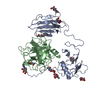 7wqwC 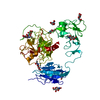 7wqxC  7wqzC 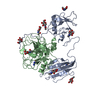 7wr7C 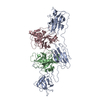 8h3sC M: map data used to model this data C: citing same article ( |
|---|---|
| Similar structure data | Similarity search - Function & homology  F&H Search F&H Search |
- Links
Links
- Assembly
Assembly
| Deposited unit | 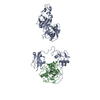
|
|---|---|
| 1 |
|
- Components
Components
| #1: Antibody | Mass: 66652.852 Da / Num. of mol.: 1 Source method: isolated from a genetically manipulated source Source: (gene. exp.)  Homo sapiens (human) / Gene: TMPRSS15, ENTK, PRSS7 / Production host: Homo sapiens (human) / Gene: TMPRSS15, ENTK, PRSS7 / Production host:  Homo sapiens (human) / References: UniProt: P98073 Homo sapiens (human) / References: UniProt: P98073 |
|---|---|
| #2: Protein | Mass: 26277.760 Da / Num. of mol.: 1 / Mutation: H825A,D876A,S971A Source method: isolated from a genetically manipulated source Source: (gene. exp.)  Homo sapiens (human) / Gene: TMPRSS15, ENTK, PRSS7 / Production host: Homo sapiens (human) / Gene: TMPRSS15, ENTK, PRSS7 / Production host:  Homo sapiens (human) / References: UniProt: P98073 Homo sapiens (human) / References: UniProt: P98073 |
| Has protein modification | Y |
-Experimental details
-Experiment
| Experiment | Method: ELECTRON MICROSCOPY |
|---|---|
| EM experiment | Aggregation state: PARTICLE / 3D reconstruction method: single particle reconstruction |
- Sample preparation
Sample preparation
| Component | Name: inhibitor-bound EP, polyA model / Type: COMPLEX / Entity ID: all / Source: RECOMBINANT |
|---|---|
| Source (natural) | Organism:  Homo sapiens (human) Homo sapiens (human) |
| Source (recombinant) | Organism:  Homo sapiens (human) Homo sapiens (human) |
| Buffer solution | pH: 7.6 |
| Specimen | Embedding applied: NO / Shadowing applied: NO / Staining applied: NO / Vitrification applied: YES |
| Vitrification | Cryogen name: ETHANE |
- Electron microscopy imaging
Electron microscopy imaging
| Experimental equipment |  Model: Titan Krios / Image courtesy: FEI Company |
|---|---|
| Microscopy | Model: FEI TITAN KRIOS |
| Electron gun | Electron source:  FIELD EMISSION GUN / Accelerating voltage: 300 kV / Illumination mode: FLOOD BEAM FIELD EMISSION GUN / Accelerating voltage: 300 kV / Illumination mode: FLOOD BEAM |
| Electron lens | Mode: BRIGHT FIELD / Nominal defocus max: 3500 nm / Nominal defocus min: 1000 nm |
| Image recording | Electron dose: 52 e/Å2 / Film or detector model: GATAN K2 SUMMIT (4k x 4k) |
- Processing
Processing
| Software | Name: PHENIX / Version: 1.17.1_3660: / Classification: refinement | ||||||||||||||||||||||||
|---|---|---|---|---|---|---|---|---|---|---|---|---|---|---|---|---|---|---|---|---|---|---|---|---|---|
| EM software | Name: PHENIX / Category: model refinement | ||||||||||||||||||||||||
| CTF correction | Type: PHASE FLIPPING AND AMPLITUDE CORRECTION | ||||||||||||||||||||||||
| 3D reconstruction | Resolution: 4.7 Å / Resolution method: FSC 0.143 CUT-OFF / Num. of particles: 119676 / Symmetry type: POINT | ||||||||||||||||||||||||
| Refine LS restraints |
|
 Movie
Movie Controller
Controller








 PDBj
PDBj

